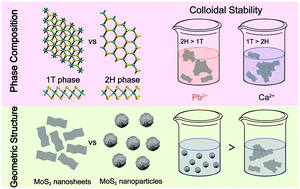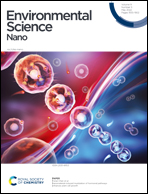Emerging investigator series: correlating phase composition and geometric structure to the colloidal stability of 2D MoS2 nanomaterials†
Abstract
Aggregation significantly influences the transport, transformation and bioavailability of engineered nanomaterials in aquatic environments. As one of the most well-studied two-dimensional transition metal dichalcogenide nanomaterials, the colloidal stability of molybdenum disulfide (MoS2) has been reported under different environmental conditions. Nonetheless, the intrinsic aggregation behavior of this material as influenced by its physicochemical properties is not well understood. This study investigated the correlation of the phase composition and geometric structure of MoS2 with the aggregation behavior, aggregate stability and transport behavior of the nanomaterials. The results revealed that soft Lewis acid Pb2+ exhibits higher destabilization for metallic 1T MoS2, whereas the semiconducting 2H phase has a higher tendency to aggregate in the presence of hard Lewis acid Ca2+. The different colloidal stabilities in response to cations could be well explained by the inner-sphere complexation of Pb2+ and outer-sphere interaction of Ca2+ with the surface of MoS2, respectively. With respect to the influences of geometric structure on the colloidal stability, the suspension of flower-like MoS2 3D nanoparticles is more stable compared to its 2D nanosheet counterpart, as reflected by the higher critical coagulation concentrations of cations and lower aggregation rate at the same MoS2 mass concentration. Finally, redispersion and column experiments were conducted to evaluate the stabilities and remigration behavior of MoS2 aggregates. Deposition of MoS2 nanomaterials occurred in the presence of cations and the aggregates of MoS2 3D nanoparticles were shown to be unstable and susceptible to redispersion/remigration due to the loose aggregate structure. This study comprehensively evaluated the intrinsic aggregation behaviors of engineered MoS2 nanomaterials with important implications for environmental fate and risk.

- This article is part of the themed collections: Environmental fate of nanomaterials, Environmental Science: Nano Recent HOT Articles and Emerging Investigators Series


 Please wait while we load your content...
Please wait while we load your content...